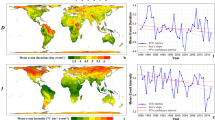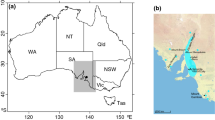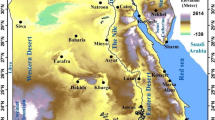Abstract
Anthropogenic climate change has affected the frequency and duration of extreme climate events, including extreme heat events (EHE) and extreme cold events (ECE). How the frequency and duration of both EHE and ECE have changed over time within both terrestrial and marine environments globally has not been fully explored. Here, we use detrended daily estimates of minimum and maximum temperature from the ERA5 reanalysis over a 70-year period (1950–2019) to estimate the daily occurrence of EHE and ECE across the globe. We measure the frequency and duration of EHE and ECE by season across years and estimate how these measures have changed over time. Frequency and duration for both EHE and ECE presented similar patterns characterized by low spatial heterogeneity and strong seasonal variation. High EHE frequency and duration occurred within the Antarctic during the austral summer and winter and within the Arctic Ocean during the boreal winter. High ECE frequency and duration occurred within the Nearctic and Palearctic during the boreal winter and the Arctic Ocean during the boreal summer. The trend analysis presented pronounced differences between frequency and duration, high spatial heterogeneity, especially within terrestrial environments, and strong seasonal variation. Positive EHE trends, primarily in duration within marine environments, occurred during the boreal summer within the mid-latitudes of the Northern Hemisphere and during the austral summer within the mid-latitudes of the Southern Hemisphere. The eastern tropical Pacific contained positive EHE and ECE trends, primary in duration during the boreal winter. Our findings emphasize the many near-term challenges that extreme temperature events are likely to pose for human and natural systems within terrestrial and marine environments, and the need to advance our understanding of the developing long-term implications of these changing dynamics as climate change progresses.








Similar content being viewed by others
References
AghaKouchak A et al (2020) Climate extremes and compound hazards in a warming world. Annu Rev Earth Planet Sci 48:519–548. https://doi.org/10.1146/annurev-earth-071719-055228
Alexander LV et al (2006) Global observed changes in daily climate extremes of temperature and precipitation. J Geophys Res Atmos 111:D05109. https://doi.org/10.1029/2005JD006290
Anderson GB, Bell Michelle L (2011) Heat waves in the United States: mortality risk during heat waves and effect modification by heat wave characteristics in 43 U.S. communities. Environ Health Perspect 119:210–218. https://doi.org/10.1289/ehp.1002313
Bailey LD, van de Pol M (2016) Tackling extremes: challenges for ecological and evolutionary research on extreme climatic events. J Anim Ecol 85:85–96. https://doi.org/10.1111/1365-2656.12451
Battisti DS, Naylor RL (2009) Historical warnings of future food insecurity with unprecedented seasonal heat. Science 323:240. https://doi.org/10.1126/science.1164363
Bell B et al (2020) ERA5 hourly data on single levels from 1950 to 1978 (preliminary version). Copernicus climate change service (C3S) climate data store (CDS). (accessed on < 12-01-2020 >), https://cds.climate.copernicus-climate.eu/cdsapp#!/dataset/reanalysis-era5-single-levels-preliminary-back-extension?tab=overview
Buehler T, Raible CC, Stocker TF (2011) The relationship of winter season North Atlantic blocking frequencies to extreme cold or dry spells in the ERA-40. Tellus A: Dynamic Meteorology and Oceanography 63:174–187. https://doi.org/10.1111/j.1600-0870.2010.00492.x
Cai W et al (2014) Increasing frequency of extreme El Nino events due to greenhouse warming. Nature Clim Change 4:111–116. https://doi.org/10.1038/nclimate2100
Cai W et al (2015) ENSO and greenhouse warming. Nat Clim Chang 5:849–859. https://doi.org/10.1038/nclimate2743
Cayan DR (1980) Large-scale relationships between sea surface temperature and surface air temperature. Mon Weather Rev 108:1293–1301. https://doi.org/10.1175/1520-0493(1980)108<1293:LSRBSS>2.0.CO;2
Colominas MA, Schlotthauer G, Torres M, Flandrin P (2012) Noise-assisted EMD methods in action. Advances in Data Science and Adaptive Analysis:4
Coumou D, Robinson A (2013) Historic and future increase in the global land area affected by monthly heat extremes. Environ Res Lett 8:034018. https://doi.org/10.1088/1748-9326/8/3/034018
Cremonese E, Filippa G, Galvagno M, Siniscalco C, Oddi L, Morra di Cella U, Migliavacca M (2017) Heat wave hinders green wave: the impact of climate extreme on the phenology of a mountain grassland. Agric For Meteorol 247:320–330. https://doi.org/10.1016/j.agrformet.2017.08.016
Cribari-Neto F, Zeileis A (2010) Beta Regression in R. J Stat Softw 34:1–24
Diffenbaugh NS et al (2017) Quantifying the influence of global warming on unprecedented extreme climate events. Proc Natl Acad Sci U S A 114:4881. https://doi.org/10.1073/pnas.1618082114
Fenner D, Holtmann A, Krug A, Scherer D (2019) Heat waves in Berlin and Potsdam, Germany – Long-term trends and comparison of heat wave definitions from 1893 to 2017. Int J Climatol 39:2422–2437. https://doi.org/10.1002/joc.5962
Ferrari S, Cribari-Neto F (2004) Beta regression for modelling rates and proportions. J Appl Stat 31:799–815. https://doi.org/10.1080/0266476042000214501
Fischer EM, Knutti R (2015) Anthropogenic contribution to global occurrence of heavy-precipitation and high-temperature extremes. Nat Clim Chang 5:560. https://doi.org/10.1038/nclimate2617
Flanders Marine Institute (2018) IHO Sea Areas, version 3. Available online at http://www.marineregions.org/. doi:https://doi.org/10.14284/323
Frölicher TL, Fischer EM, Gruber N (2018) Marine heatwaves under global warming. Nature 560:360–364. https://doi.org/10.1038/s41586-018-0383-9
Garrabou J et al (2009) Mass mortality in northwestern Mediterranean rocky benthic communities: effects of the 2003 heat wave. Glob Change Biol 15:1090–1103. https://doi.org/10.1111/j.1365-2486.2008.01823.x
Grant PR, Grant BR, Huey RB, Johnson MTJ, Knoll AH, Schmitt J (2017) Evolution caused by extreme events. Philos Trans R Soc Lond Ser B Biol Sci 372:20160146. https://doi.org/10.1098/rstb.2016.0146
Guo Y et al (2017) Heat wave and mortality: a multicountry, multicommunity study. Environ Health Perspect 125:087006. https://doi.org/10.1289/EHP1026
Gutschick VP, BassiriRad H (2003) Extreme events as shaping physiology, ecology, and evolution of plants: toward a unified definition and evaluation of their consequences. New Phytol 160:21–42. https://doi.org/10.1046/j.1469-8137.2003.00866.x
Harris RMB et al (2018) Biological responses to the press and pulse of climate trends and extreme events. Nat Clim Chang 8:579–587. https://doi.org/10.1038/s41558-018-0187-9
Helske J, Luukko P (2018) Rlibeemd: ensemble empirical mode decomposition (EEMD) and its complete variant (CEEMDAN). R package version 1(4):1 https://github.com/helske/Rlibeemd
Hersbach H et al. (2019a) ERA5 monthly averaged data on single levels from 1979 to present. Copernicus climate change service (C3S) climate data store (CDS). (accessed on < 02-14-2020 >). DOI: https://doi.org/10.24381/cds.f17050d7
Hersbach H et al (2019b) Global reanalysis: goodbye ERA-interim, hello ERA5. ECMWF Newsletter:17–24
Hoffmann L et al (2019) From ERA-interim to ERA5: the considerable impact of ECMWF's next-generation reanalysis on Lagrangian transport simulations. Atmos Chem Phys 19:3097–3124. https://doi.org/10.5194/acp-19-3097-2019
Huang NE et al (1998) The empirical mode decomposition and the Hilbert spectrum for nonlinear and non-stationary time series analysis. P Roy Soc Lond A Mat 454:903–995. https://doi.org/10.1098/rspa.1998.0193
Kolstad EW, Breiteig T, Scaife AA (2010) The association between stratospheric weak polar vortex events and cold air outbreaks in the northern hemisphere. Q J R Meteorol Soc 136:886–893. https://doi.org/10.1002/qj.620
Kretschmer M, Cohen J, Matthias V, Runge J, Coumou D (2018) The different stratospheric influence on cold-extremes in Eurasia and North America. Climate and Atmospheric Science 1:44. https://doi.org/10.1038/s41612-018-0054-4
La Sorte FA, Hochachka WM, Farnsworth A, Dhondt AA, Sheldon D (2016) The implications of mid-latitude climate extremes for north American migratory bird populations. Ecosphere 7:e01261
La Sorte FA, Fink D, Johnston A (2018) Seasonal associations with novel climates for north American migratory bird populations. Ecol Lett 21:845–856. https://doi.org/10.1111/ele.12951
Lambert D (1992) Zero-inflated Poisson regression, with an application to defects in manufacturing. Technometrics 34:1–14. https://doi.org/10.2307/1269547
Lupo AR, Jensen AD, Mokhov II, Timazhev AV, Eichler T, Efe B (2019) Changes in global blocking character in recent decades. Atmosphere 10:92
Luukko PJ, Helske J, Räsänen E (2016) Introducing libeemd: a program package for performing the ensemble empirical mode decomposition. Comput Stat 31:545–557. https://doi.org/10.1007/s00180-015-0603-9
Mair P, Wilcox R (2019) Robust statistical methods in R using the WRS2 package. Beh Res Meth. https://doi.org/10.3758/s13428-019-01246-w
Maron M, McAlpine CA, Watson JEM, Maxwell S, Barnard P (2015) Climate-induced resource bottlenecks exacerbate species vulnerability: a review. Divers Distrib 21:731–743. https://doi.org/10.1111/ddi.12339
Maxwell SL et al (2019) Conservation implications of ecological responses to extreme weather and climate events. Divers Distrib 25:613–625. https://doi.org/10.1111/ddi.12878
McPhillips LE et al (2018) Defining extreme events: a cross-disciplinary review. Earth’s Future 6:441–455. https://doi.org/10.1002/2017EF000686
Mendes MCD, Cavalcanti IFA (2014) The relationship between the Antarctic oscillation and blocking events over the South Pacific and Atlantic Oceans. Int J Climatol 34:529–544. https://doi.org/10.1002/joc.3729
Mitchell D et al (2016) Attributing human mortality during extreme heat waves to anthropogenic climate change. Environ Res Lett 11:074006. https://doi.org/10.1088/1748-9326/11/7/074006
Molla MKI, Sumi A, Rahman MS (2007) Analysis of temperature change under global warming impact using empirical mode decomposition. Int J Inf Technol 3:131–139
Oliver ECJ et al (2018) Longer and more frequent marine heatwaves over the past century. Nat Commun 9:1324. https://doi.org/10.1038/s41467-018-03732-9
Olson DM, Dinerstein E (2002) The global 200: priority ecoregions for global conservation. Ann Mo Bot Gard 89:199–224
Oswald EM (2018) An analysis of the prevalence of heat waves in the United States between 1948 and 2015. J Appl Meteorol Clim 57:1535–1549. https://doi.org/10.1175/JAMC-D-17-0274.1
Parker WS (2016) Reanalyses and observations: what’s the difference? B Am Meteorol Soc 97:1565–1572. https://doi.org/10.1175/bams-d-14-00226.1
Perkins-Kirkpatrick SE, Lewis SC (2020) Increasing trends in regional heatwaves. Nat Commun 11:3357. https://doi.org/10.1038/s41467-020-16970-7
Pfahl S, Wernli H (2012) Quantifying the relevance of atmospheric blocking for co-located temperature extremes in the Northern Hemisphere on (sub-)daily time scales. Geophys Res Lett 39. https://doi.org/10.1029/2012GL052261
Pielou EC (1979) Biogeography. Wiley, NY
R Development Core Team (2020) R: a language and environment for statistical computing. R Foundation for Statistical Computing https://www.R-project.org/, Vienna, Austria
Röthlisberger M, Pfahl S, Martius O (2016) Regional-scale jet waviness modulates the occurrence of midlatitude weather extremes. Geophys Res Lett 43:10,989–910,997. https://doi.org/10.1002/2016GL070944
Röthlisberger M, Frossard L, Bosart LF, Keyser D, Martius O (2019) Recurrent synoptic-scale Rossby wave patterns and their effect on the persistence of cold and hot spells. J Clim 32:3207–3226. https://doi.org/10.1175/JCLI-D-18-0664.1
Sillmann J, Croci-Maspoli M, Kallache M, Katz RW (2011) Extreme cold winter temperatures in Europe under the influence of North Atlantic atmospheric blocking. J Clim 24:5899–5913. https://doi.org/10.1175/2011JCLI4075.1
Simas AB, Barreto-Souza W, Rocha AV (2010) Improved estimators for a general class of beta regression models. Computational Statistics & Data Analysis 54:348–366. https://doi.org/10.1016/j.csda.2009.08.017
Smale DA et al (2019) Marine heatwaves threaten global biodiversity and the provision of ecosystem services. Nat Clim Chang 9:306–312. https://doi.org/10.1038/s41558-019-0412-1
Smith ET, Sheridan SC (2018) The characteristics of extreme cold events and cold air outbreaks in the eastern United States. Int J Climatol 38:e807–e820. https://doi.org/10.1002/joc.5408
Smith ET, Sheridan SC (2019) The influence of extreme cold events on mortality in the United States. Sci Total Environ 647:342–351. https://doi.org/10.1016/j.scitotenv.2018.07.466
Smith TT, Zaitchik BF, Gohlke JM (2013) Heat waves in the United States: definitions, patterns and trends. Clim Chang 118:811–825. https://doi.org/10.1007/s10584-012-0659-2
Smithson M, Verkuilen J (2006) A better lemon squeezer? Maximum-likelihood regression with beta-distributed dependent variables. Psychol Methods 11:54–71. https://doi.org/10.1037/1082-989X.11.1.54
Stallone A, Cicone A, Materassi M (2020) New insights and best practices for the successful use of empirical mode decomposition, iterative filtering and derived algorithms. Sci Rep 10:15161. https://doi.org/10.1038/s41598-020-72193-2
Torres ME, Colominas MA, Schlotthauer G, Flandrin P (2011) A complete ensemble empirical mode decomposition with adaptive noise. In: 2011 IEEE International Conference on Acoustics, Speech and Signal Processing (ICASSP), pp 4144–4147. https://doi.org/10.1109/ICASSP.2011.5947265
Trenberth KE, Caron JM, Stepaniak DP, Worley S (2002) Evolution of El Niño–Southern oscillation and global atmospheric surface temperatures. J Geophys Res Atmos 107:AAC 5–1-AAC 5–17. https://doi.org/10.1029/2000JD000298
Trenberth KE, Stepaniak DP, Smith L (2005) Interannual variability of patterns of atmospheric mass distribution. J Clim 18:2812–2825. https://doi.org/10.1175/jcli3333.1
Walsh JE, Phillips AS, Portis DH, Chapman WL (2001) Extreme cold outbreaks in the United States and Europe, 1948–99. J Clim 14:2642–2658. https://doi.org/10.1175/1520-0442(2001)014<2642:ECOITU>2.0.CO;2
Wang G et al (2017) Continued increase of extreme El Niño frequency long after 1.5 °C warming stabilization. Nat Clim Chang 7:568–572. https://doi.org/10.1038/nclimate3351
Warton DI, Lyons M, Stoklosa J, Ives AR (2016) Three points to consider when choosing a LM or GLM test for count data. Methods Ecol Evol 7:882–890. https://doi.org/10.1111/2041-210X.12552
Weiss NA (2015) wPerm: permutation tests. R package version 1.0.1. https://CRAN.R-project.org/package=wPerm
Wernberg T et al (2013) An extreme climatic event alters marine ecosystem structure in a global biodiversity hotspot. Nat Clim Chang 3:78–82. https://doi.org/10.1038/nclimate1627
Whan K, Zwiers F, Sillmann J (2016) The influence of atmospheric blocking on extreme winter minimum temperatures in North America. J Clim 29:4361–4381. https://doi.org/10.1175/JCLI-D-15-0493.1
Wheeler DD, Harvey VL, Atkinson DE, Collins RL, Mills MJ (2011) A climatology of cold air outbreaks over North America: WACCM and ERA-40 comparison and analysis. J Geophys Res Atmos 116. https://doi.org/10.1029/2011JD015711
Williams JW, Jackson ST (2007) Novel climates, no-analog communities, and ecological surprises. Front Ecol Environ 5:475–482
Williams JW, Jackson ST, Kutzbach JE (2007) Projected distributions of novel and disappearing climates by 2100 AD. Proc Natl Acad Sci U S A 104:5738–5742
Wood SN (2017) Generalized additive models: an introduction with R, 2nd edn. Chapman & Hall/CRC, Boca Raton, FL
Wu Z, Huang NE (2009) Ensemble empirical mode decomposition: a noise-assisted data analysis method. Adv Adapt Data Anal 01:1–41. https://doi.org/10.1142/s1793536909000047
Wu Z, Huang NE, Long SR, Peng C-K (2007) On the trend, detrending, and variability of nonlinear and nonstationary time series. Proc Natl Acad Sci U S A 104:14889. https://doi.org/10.1073/pnas.0701020104
Acknowledgements
We thank two anonymous reviewers for the construction comments on an earlier draft and D. Sheldon and The College of Information and Computer Sciences, University of Massachusetts, for the computational support.
Funding
This research was supported by The Wolf Creek Charitable Foundation and the National Science Foundation (DBI-1939187; DEB-2017817).
Author information
Authors and Affiliations
Corresponding author
Ethics declarations
Conflict of interest
The authors declare no competing interests.
Additional information
Publisher’s note
Springer Nature remains neutral with regard to jurisdictional claims in published maps and institutional affiliations.
Rights and permissions
About this article
Cite this article
La Sorte, F.A., Johnston, A. & Ault, T.R. Global trends in the frequency and duration of temperature extremes. Climatic Change 166, 1 (2021). https://doi.org/10.1007/s10584-021-03094-0
Received:
Accepted:
Published:
DOI: https://doi.org/10.1007/s10584-021-03094-0




